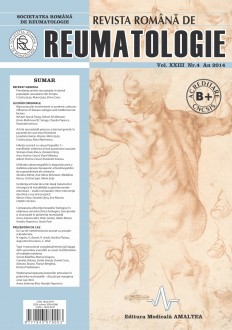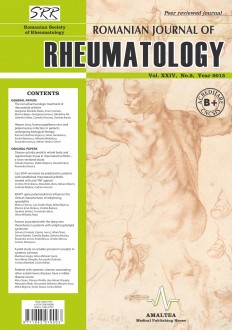SELECT ISSUE

Indexed

| |

|
|
|
| |
|
|
|

|
|
|
|
|
|
| |
|
|
HIGHLIGHTS
National Awards “Science and Research”
NEW! RJR has announced the annually National Award for "Science and Research" for the best scientific articles published throughout the year in the official journal.
Read the Recommendations for the Conduct, Reporting, Editing, and Publication of Scholarly work in Medical Journals.
The published medical research literature is a global public good. Medical journal editors have a social responsibility to promote global health by publishing, whenever possible, research that furthers health worldwide.
INFECTIA CRONICA CU VIRUSUL HEPATITIC C – MANIFESTARI SISTEMICE SI BOLI AUTOIMUNE ASOCIATE
Sînziana Daia-Iliescu, Daniela Opris, Anca Streinu-Cercel, Viorel Văleanu, Adrian Streinu-Cercel and Ruxandra Ionescu
REZUMAT
Pacienţii cu infecţie cronică cu virus hepatitic C (VHC) pot prezenta o gamă largă de manifestări ca subfebră, astenie, fatigabilitate, artrite/artralgii, sindrom Sicca, mialgii, purpură, depresie sau titruri înalte de autoanticorpi. Acestea pot fi încadrate ca manifestări extrahepatice (MEH) ce însoţesc infecţia virală sau pot face parte din tabloul clinic al unei boli autoimune asociate.
Obiective. Studiul îşi propune descrierea prezenţei MEH a infecţiei cronice VHC şi a asocierii cu diverse boli autoimune în lotul studiat şi compararea diferitelor patternuri imunologice asociate.
Material şi metodă. S-a realizat un studiu descriptiv, transversal, pe un lot de pacienţi ce asociază hepatită cronică VHC şi o afecţiune reumatică, internaţi consecutiv într-o perioadă de 3 ani. S-au analizat MEH ca şi boală reumatică asociată ce i-a adus la medic. Pentru colectarea şi interpretarea datelor s-a folosit SPSS STATISTICS, corelaţia Pearson şi testul x2.
Rezultate. Studiul a inclus 91 (81,25%) de pacienţi de sex feminin şi 21 (18,75%) de pacienţi de sex masculin, predominând grupa de vârstă 51-60 de ani – 36 (32,14%) de pacienţi. 29 (25,89%) dintre pacienţii sub 60 de ani şi 38 (33,93%) dintre pacienţii peste 60 de ani prezintă MEH. 39 (40,42%) dintre MEH sunt reumatice (artrite/artralgii la 29 (72,5%) de pacienţi, sindrom Sicca – 8 (20%) pacienţi, crioglobulinemie 3 (7,5%) pacienţi), 14 (14,58%) endocrinologice (tiroidită Hashimoto – 7 (6,25%) pacienţi femei); diabet zaharat – 12 (13,18%) femei şi 5 (23,8%) – bărbaţi), 21 (28,12%) neuropsihice (neuropatie – 9 (9,89%) femei şi 1 (4,76%) bărbat, astenie fizică – 5 femei şi 1 bărbat, sindrom depresiv – 8 femei şi 1 bărbat), 5 (5,2%) dermatologice şi 11 (11,45%) pacienţi metabolici. Dintre bolile reumatice, pacienţii au asociat cel mai frecvent poliartrita reumatoidă – 36 (32,14%) de pacienţi, spon dilartrite 7 (6,25%) pacienţi, LES 4 (3,57%) pacienţi, scleroză sistemică şi boală Still întâlnindu-se la câte 2 (1,79%) pacienţi.
Concluzii. Prevalenţa manifestărilor extrahepatice la pacienţii cu infecţie cronică VHC este considerabilă. Diagnosticul diferenţial al afecţiunilor autoimune ce însoţesc infecţia virală este important, pacienţii trebuind astfel investigaţi complex şi trataţi multidisciplinar.
Cuvinte cheie: HCV, manifestări sistemice, boli autoimune

